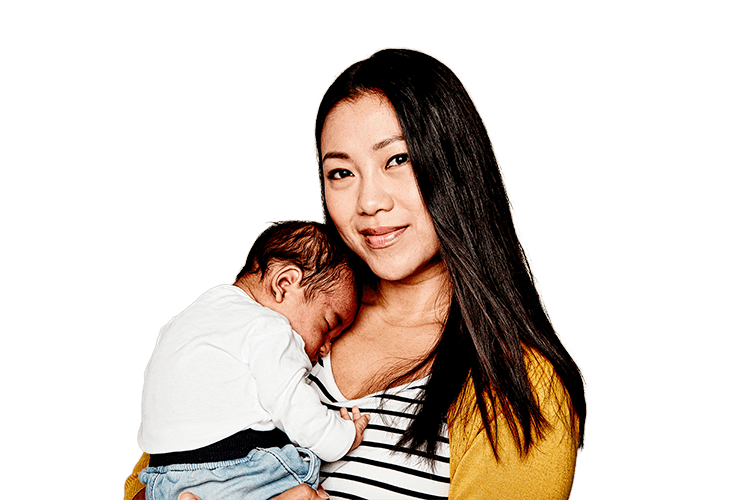There are many different reasons why your doctor may recommend a caesarean.
Whether the recommendation comes in advance or on the day, don’t be afraid to ask lots of questions, including your doctor’s caesarean rate and what the relative risks are for a vaginal versus a caesarean birth in your case. The safety of the mother and baby are paramount and ultimately, you and your obstetrician will decide what the safest option is for you and your baby.
If you are having a caesarean, it’s good to know what to expect. We outline what happens when you have a caesarean section.

Pre-surgery
If it’s an elective procedure you’ll be asked to fast beforehand. If it’s an emergency caesarean, you’ll be asked when you last ate or drank so that the doctor can prepare accordingly. Either way, you will need to sign a form to consent to the surgery.
Anaesthetic options
- Spinal anaesthetic: This is the most common type of anaesthetic for an elective caesarean. It’s relatively painless as the anaesthetist will give you a local anaesthetic before using a longer needle to inject anaesthetic between your spinal vertebrae and numb your nerves from the waist down. You will be conscious during the birth and you may feel painless tugging or pushing sensations. You will also need a urinary catheter. The anaesthetic generally wears off after 2 – 6 hours.
- Epidural: An epidural will make you feel numb from the waist down, but unlike a spinal anaesthetic, you can still move your legs and walk around. After the anaesthetist has given you a local anaesthetic, they will inject anaesthetic into the space around your spinal cord. They then insert a small plastic tube so that they can ‘top up’ your epidural. If you’ve been given an epidural in preparation for a vaginal birth, it can be topped up for a caesarean. You will be conscious and may experience some painless sensations of the birth. You will also need a urinary catheter.
- General anaesthetic: This is the least common option. It may be required in cases where the baby needs to be born quickly. You will not be awake or feel anything.
The procedure
The entire procedure typically takes between 30-60 minutes including removal of the placenta and stitching, and you can have a support person in theatre with you (who is welcome to bring a camera to photograph the birth).
Once your anaesthetic is in place, you will be taken to the operating room and placed in the correct position. Your obstetrician will paint your abdomen with anaesthetic wash and you will be covered in sterile drapes.
Your obstetrician will make an incision in your stomach and uterus. Wherever possible the incision will run horizontally across the lower stomach, which is better for healing and means the scar is less visible. The incision into the stomach and uterus is approximately 10cm long.
The baby is then lifted out through the incision.
After the baby is born
The baby will be checked, weighed and have its umbilical cord cut. He or she will then be brought to you to see or hold. You will be able to hold your baby soon after the procedure, if not in the theatre.
The placenta is usually removed shortly after your baby is delivered. Your uterus will then be stitched up with dissolvable stitches and your stomach will be either stitched or stapled back together and covered with a sterile dressing. You’ll be given medication to make the uterus contract and to minimize bleeding.
Your doctor may prescribe you antibiotics to reduce the risk of infection and pain relief medications. Try and stay on top of the pain, particularly in the first few days as it's easier to prevent pain before it starts than treat it afterwards.
Find out more about how to take care of yourself in the weeks afterwards .
Need a little extra support?
Health Concierge
Eligible members with hospital cover can now talk to a member of our Health Concierge team for advice and guidance on how to have a healthy pregnancy, at no extra cost on 1800 789 414.#
Got a health question? 24/7 Medibank Nurse Support
Medibank health insurance members can chat to a registered nurse over the phone or online to discuss any health questions or concerns at no extra cost.~ Chat online or call 1800 644 325 24 hours a day, 7 days a week.
24/7 Medibank Mental Health Support
Medibank members with health insurance can talk with a mental health professional over the phone or online in relation to any mental health or emotional concern at no extra cost.~ Log in or call 1800 644 325, 24 hours a day 7 days a week.
Looking for something else?
Visit Medibank Planning, Pregnancy and Parenting for a range of tools and advice to help you at every stage of your pregnancy journey.
Help the way you want it
Contact us
Call us on 134 190 to speak to a consultant. Alternatively, chat to us 24/7 online.
Self-service options
Login to MyMedibank or Download the MyMedibank App for self service options.
Find a specialist
Find a specialist or Member's choice hospital using our find a provider tool.

Things you should know
~ Some referred services may involve out of pocket costs and waiting periods may apply.
# Health Concierge is available to all eligible Medibank members who hold hospital cover. Excludes Overseas Visitor Health Cover, Working Visa Health Cover and Overseas Student Health Cover (OSHC). Some referred services may involve out of pocket costs.
While we hope you find this information helpful, please note that it is general in nature. It is not health advice, and is not tailored to meet your individual health needs. You should always consult a trusted health professional before making decisions about your health care. While we have prepared the information carefully, we can’t guarantee that it is accurate, complete or up-to-date. And while we may mention goods or services provided by others, we aren’t specifically endorsing them and can’t accept responsibility for them. For these reasons we are unable to accept responsibility for any loss that may be sustained from acting on this information (subject to applicable consumer guarantees).